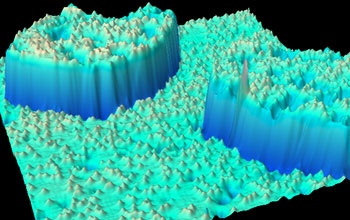Multimedia Gallery
Atomic Scale Alloying of Chromium Atoms
A scanning tunneling microscope (STM) image (35 x 35 nanometers) showing atomic scale alloying of chromium atoms (small yellow bumps) on an iron (001) surface, which occurs when chromium atoms are deposited on the iron surface. The two islands are single atomic steps composed of iron atoms that were "kicked" out of the surface by the deposited chromium atoms. The islands also show some alloyed chromium atoms. The chromium atoms reside in an iron lattice site as a substitutional impurity which can be distinguished from the surrounding iron atoms using tunneling spectroscopy. The chromium impurities at the iron-chromium interface have a significant effect on the magnetic properties of films composed of layers of iron and chromium. (Date of Image: 1996)
More about this Image
Researchers in the Electron Physics Group at NIST have studied the coupling effects between magnetic layers separated by non-magnetic layers. Test structures are grown using thin film deposition, typically making a sandwich of three layers; top and bottom magnetic layers, and a non-magnetic layer placed between the two magnetic layers. Dramatic changes in the electrical resistivity, known as the Giant Magnetoresistance (GMR) effect, occur when the magnetic alignment of the two magnetic layers is switched from being parallel to anti-parallel. The material system that was used to initially study these magnetic coupling effects was a three layer system composed of iron/chromium/iron. Researchers at NIST noticed anomalous magnetic behavior in these systems when the chromium layers were very thin. It also seemed that the chromium films acted as if their thickness differed by a single atomic monolayer from their prepared dimensions. Several anomalies were resolved by the image above, which was part of a study of the atomic scale properties of chromium film growth on an iron surface. This STM study used growth conditions similar to those of the magnetic studies. As seen in the STM image above, the chromium did not initially grow in a perfect uniform film. The iron-chromium interface is not abrupt as researchers initially thought, but consists of an iron chromium alloy that affects the magnetic coupling in these systems. The alloy is formed when the chromium atoms displace iron atoms in the top iron surface layer. The "freed" iron atoms can then diffuse to form growth islands. Researchers at NIST were able to distinguish the chromium impurity atoms from the iron atoms using scanning tunneling spectroscopy. The alloying process abates as further chromium is deposited and is limited to the region at the iron/chromium interface. Basic research in magnetic film growth, magnetic coupling, and GMR has lead to significant advances in magnetic technology, such as greatly increased storage capacity in the hard disk drives used in our computers today.
SORRY: THIS IMAGE IS NOT AVAILABLE IN HIGH RESOLUTION FORMAT
Credit: J. A. Stroscio, A. Davies, D. T. Pierce and R. J. Celotta, National Institute of Standards and Technology (NIST)
Images and other media in the National Science Foundation Multimedia Gallery are available for use in print and electronic material by NSF employees, members of the media, university staff, teachers and the general public. All media in the gallery are intended for personal, educational and nonprofit/non-commercial use only.
Images credited to the National Science Foundation, a federal agency, are in the public domain. The images were created by employees of the United States Government as part of their official duties or prepared by contractors as "works for hire" for NSF. You may freely use NSF-credited images and, at your discretion, credit NSF with a "Courtesy: National Science Foundation" notation.
Additional information about general usage can be found in Conditions.
Also Available:
Download the high-resolution TIF version of the image. (1 MB)
Use your mouse to right-click (Mac users may need to Ctrl-click) the link above and choose the option that will save the file or target to your computer.



